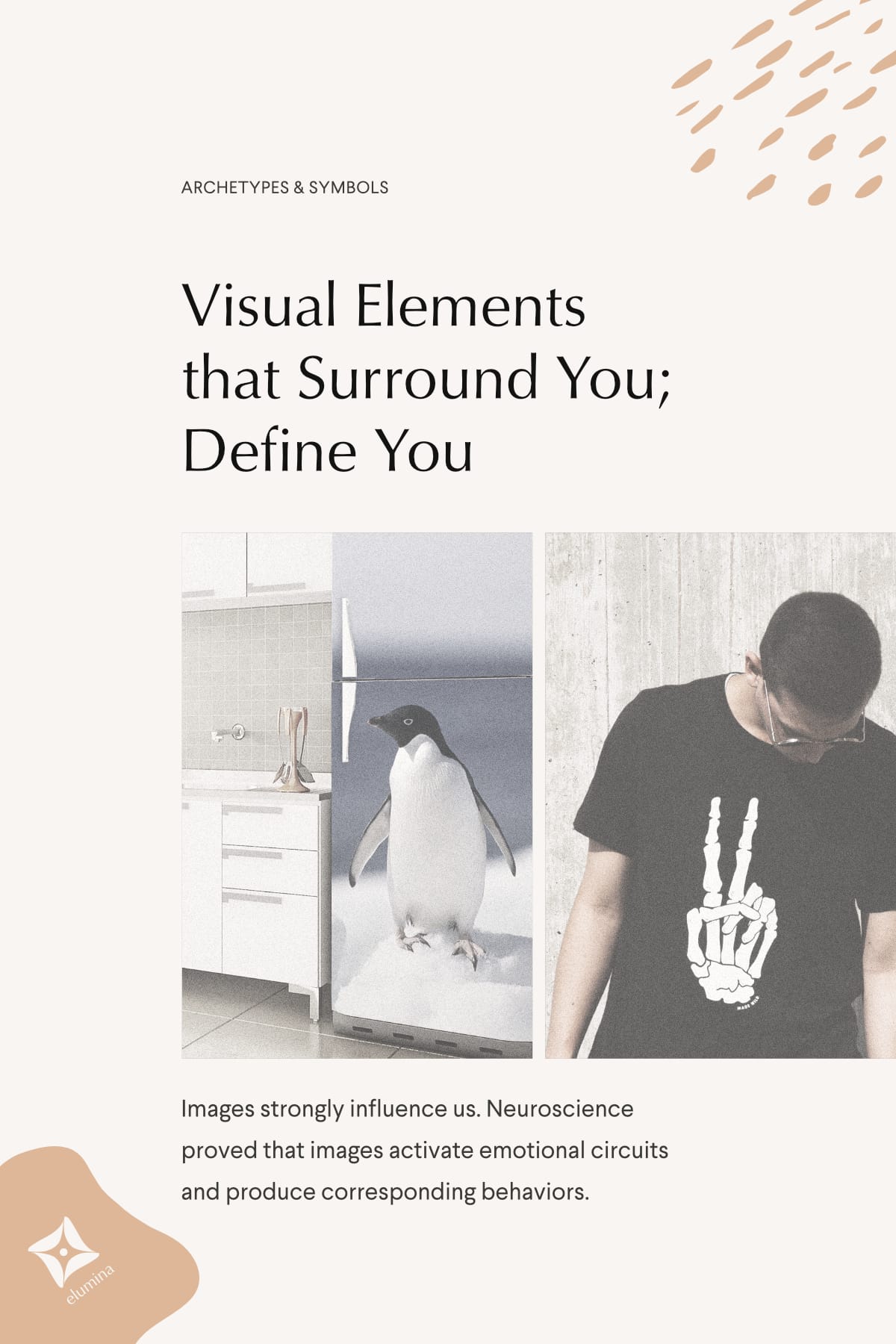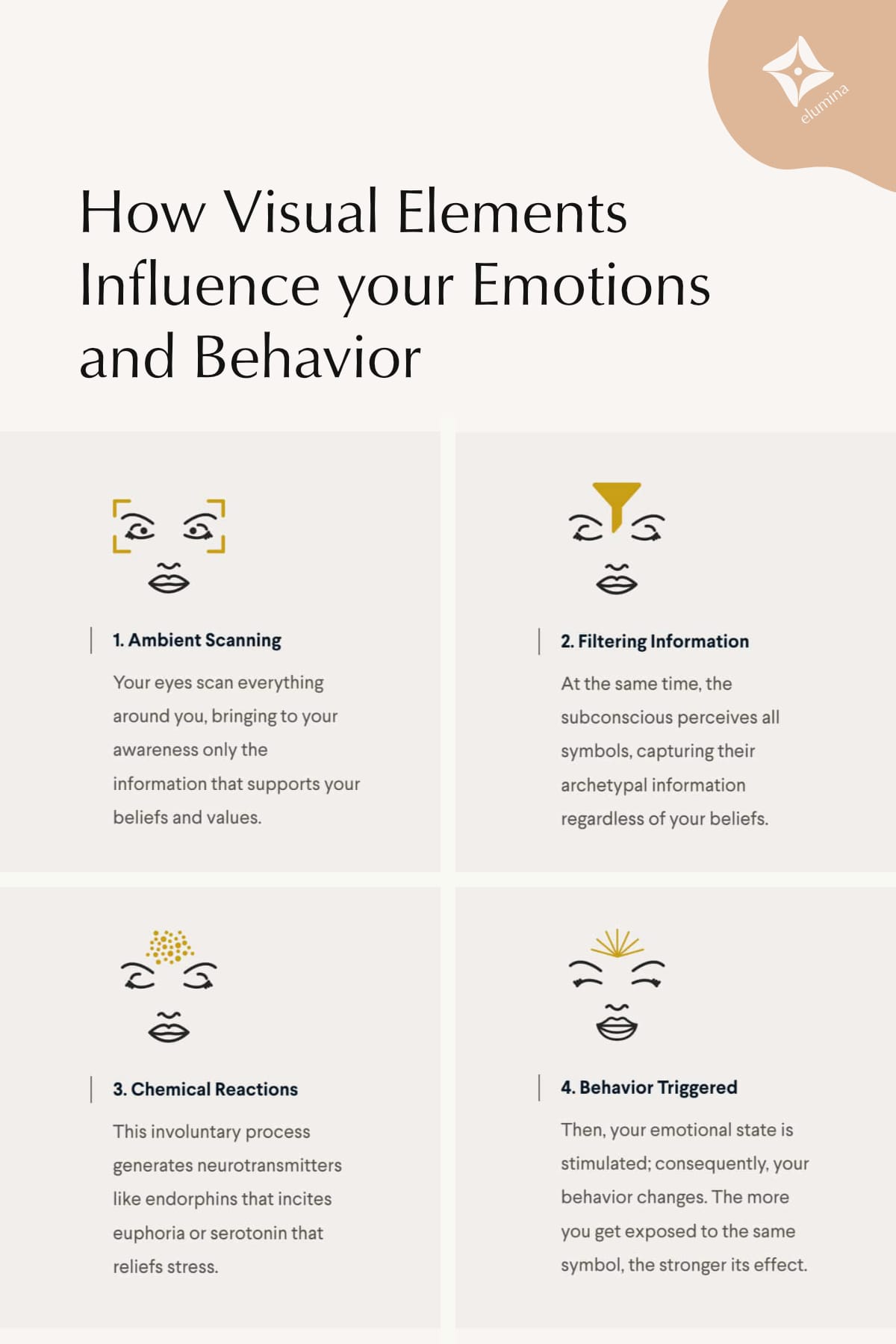Archetypes & Symbols
Visual Elements that Surround You; Define You

Look around; what visual elements do you see? A penguin on the fridge? A t-shirt full of skulls? Horse statue? Maybe you’re on public transport, and you see some ads.
At home, I bet you love many objects and clothes. But did you know that these items determine your behavior and, ultimately, how you experience life?
Images, colors, and shapes alter your emotions and, consequently, your way of thinking and acting. This is what the neuroscientist Eric J. Nestler confirmed on the biochemical level.
Yes, now we have scientific proof of what the entertainment industry, advertising, and government propaganda have been practicing for over a century to sell ideas and products.
Processing Visual Elements
Dr. Nestler demonstrated that your brain selects the surrounding visual elements most relevant to the specific situation and, ultimately, for your survival.
The selection of relevant information is the role of attention, which is processed in the conscious mind. This information activates the emotional circuits and produces the desired behaviors.
However, what is not processed by attention is processed in the subconscious mind. It doesn’t have to be reasoned to activate your emotional circuits and produce corresponding behaviors.
In conclusion, visual elements affect emotions and behavior, whether perceived or not. This is how it works:
1. Ambient Scanning
Your eyes scan everything around you, bringing to your awareness only the information you need or that supports your beliefs and values.
2. Filtering Information
At the same time, the subconscious mind perceives all symbols, capturing their archetypal meanings regardless of your beliefs and values.
3. Chemical Reactions
This involuntary process generates neurotransmitters like endorphins that incites euphoria or serotonin that relieve stress.
4. Behavior Triggered
Then, your emotional state is stimulated; consequently, your behavior changes. The more exposed you are to the same symbol, the stronger its effect.
Eric J. Nestler, MD, Ph.D. – Molecular Neuropharmacology: A Foundation for Clinical Neuroscience
For example, you go to the kitchen. You scan the room for food; you put all your attention on this mission.
But that doesn’t mean that your brain isn’t processing everything in that kitchen. Your attention ignores the penguin on the refrigerator. Still, the penguin and its meaning are processed by your unconscious, activating emotional circuits and producing behaviors.
How does that penguin affect my behavior?
Visual Elements and their Meaning
What comes to your mind when you think of it? You may answer cordiality and sociability. And it is true, these are penguin characteristics. But they are also funny, clumsy, and have wings but can’t fly.
All these characteristics unconsciously will affect you. Pay attention to the fact that almost everything in the world is binary. Therefore it has its good and bad sides. It’s vital to be aware of this to make the right choices.
If for you, penguins’ friendliness and sociability are more important than being clumsy and silly. That’s fine, but know that you will incorporate all these characteristics.
Let’s suppose that you want to become an independent, self-confident person. Clothes and ornaments with penguins and ducks will distance you from your goal.
But if you want to have a united family, these elements will help. You don’t believe it, do you?
Visual Elements Stimulate Corresponding Actions
Professors from Duke and Waterloo University found that even the briefest exposure to familiar brands can cause people to behave in ways that reflect those brands’ characteristics.
The researchers selected two competing brands with distinct and well-defined personalities. “For many years, Apple has worked to develop a brand associated with nonconformity, innovation, and creativity. And IBM with tradition and responsibility,” said Chartrand.
More than 300 participants were divided into 2 groups; one group was exposed to the Apple logo and the other group to the IBM logo. Both marks were displayed so quickly that the participants were unaware that they had been exposed to the symbol.
“We’ve offered people $100 to tell us what logo was being flashed on the screen, and none of them could do it,” said Fitzsimons.
Then they had to complete a task to assess how creative they were. People subliminally exposed to the Apple logo generated more creative responses than those from IBM.
The university team conducted a follow-up experiment using Disney Channel and E! Channel brands. Participants exposed to the Disney Channel logo behaved much more honestly than those who saw the E! Channel logo.
Archetypes and Symbols
Note that you don’t usually rationalize a company’s values or meaning. When in contact with the IBM logo, would you say: smart and responsible? The same goes for the penguin and anything else.
This happens because companies, for example, associate their products and brands with archetypes. In the early 20th century, the swiss psychologist Carl G. Jung used the concept of archetype in his theory of the human psyche, identifying 12 universal characters that reside within all of us.
Archetypes are part of the collective unconscious. No matter what geographical location and culture we belong to, we all know their characteristics.
The 12 Jungian Archetypes
- Ruler
- Creator/Artist
- Sage
- Innocent
- Explorer
- Rebel
- Hero
- Wizard
- Jester
- Everyman
- Lover
- Caregiver
IBM embodied the Ruler archetype in their marketing efforts, while Apple chose the Rebel to lead their branding efforts.
The Ruler seeks stability and control, characteristics that limit creativity. On the other hand, the Rebel looks for creative ways to change the status quo.
Did you realize how easy it is to know what to expect from people when you have this knowledge?
But what does the penguin have to do with archetypes? The penguin itself is an archetype.
Archetypes: The origin
The word archetype comes from the Greek “arkhetypos,” which means the “first imprint.” The philosopher Plato was the first person who discovered the archetypes in his ‘Theory of Forms.’
Briefly, he says: Everything that manifests in the material plane comes from the mental plane. The most famous example is a chair. Before it is built (exists on the material plane), it has to be idealized in its creator’s mind (mental plane).
Plato’s theory leaves several hints that the creator’s mind is God. Few scholars understand his theory correctly since he didn’t explicitly say it. Almost no one considers that he would be sentenced to death just like Socrates if he said so.
Misinterpretations apart, Plato’s “theory” demonstrates that everything in the universe comes from the mind of God. Plato called these Mental Creations: archetypes.
Archetypes are God’s first emanation, the perfection of everything. Therefore, the best chair we could ever build is imperfect and could only be thought of by a human through the design of God’s perfect chair: the archetype of the chair.
That is to say, symbols such as logos, mandalas, drawings, and sculptures activate the represented archetype characteristics in your unconscious, changing your emotions and, consequently, your behavior.
This subject is extensive but crucial for everyone who wants to control their professional and personal lives.
Controlling human behavior and motivation is much easier than you think.
But if it is possible to program behaviors through symbols, we can intentionally reprogram our minds with them. Symbols can be powerful tools for personal growth.
Let the magic happen!
Suggested books:
Eric J. Nestler, MD, Ph.D. - "Molecular Neuropharmacology: A Foundation for Clinical Neuroscience"
Margaret Mark, Carol Pearson - "The Hero and the Outlaw"
Share on Pinterest


